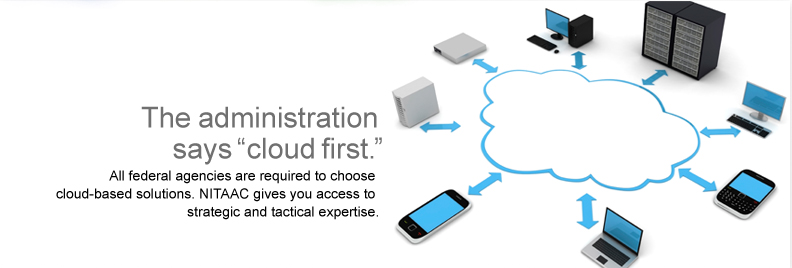
The 25-Point Plan and "cloud first."
Government IT turned a corner with a single publication: The 25-Point for IT Reform. It was here Federal CIO Vivek Kundra issued his defining directive: “Beginning immediately, the Federal Government will shift to a cloud first policy.” The OMB will require federal agencies to default to cloud-based solutions, “whenever a secure, reliable, cloud option exists.” While the benefits of cloud computing may be obvious - economy, flexibility and speed – the path to getting there is less so. There is no one-size-fits-all cloud solution, and with the speed of emerging technology, it can be hard to keep current. Fortunately, the Plan also provided government with a solution: “Increase engagement with industry."
How NITAAC can help
While you may be struggling with an appropriate cloud strategy, there are plenty of vendors who have developed and deployed cloud solutions for agencies as diverse as the USDA, the DoD and the State Department. Many of them hold contracts with NITAAC and, as a result, have been vetted for integrity and expertise.
Below, you’ll find links to NITAAC contract holders who have expertise with cloud computing, and are ready to help you understand the technology. Just as the “mythbusting campaign” points out, you can have a conversation without compromising future orders – talking to vendors is an important part of building a smart strategy. If you need us to help, just give the NITAAC Customer Support Center a call
What exactly is Cloud Computing?
The National Institute of Standards and Technology(NIST) recognizes cloud computing as an evolving paradigm, but has issued working definitions.
Cloud Computing
Cloud computing is a model for enabling convenient,
on-demand network access to a shared pool of configurable computing resources (e.g., networks, servers, storage, applications, and services) that can be rapidly provisioned and released with minimal management effort or service provider interaction. This cloud model promotes availability and is composed of five essential characteristics, three service models, and four deployment models.
Essential Characteristics
On-demand self-service. A consumer can unilaterally provision computing capabilities, such as server time and network storage, as needed automatically without requiring human interaction with each service’s provider.
Broad network access. Capabilities are available over the network and accessed through standard mechanisms that promote use by heterogeneous thin or thick client platforms (e.g., mobile phones, laptops, and PDAs).
Resource pooling. The provider’s computing resources are pooled to serve multiple consumers using a multitenant model, with different physical and virtual resources dynamically assigned and reassigned according to consumer demand. There is a sense of location independence in that the customer generally has no control or knowledge over the exact location of the provided resources but may be able to specify location at a higher level of abstraction (e.g., country, state, or datacenter). Examples of resources include storage, processing, memory, network bandwidth, and virtual machines.
Rapid elasticity. Capabilities can be rapidly and elastically provisioned, in some cases automatically, to quickly scale out and rapidly released to quickly scale in. To the consumer, the capabilities available for provisioning often appear to be unlimited and can be purchased in any quantity at any time.
Measured Service. Cloud systems automatically control and optimize resource use by leveraging a metering capability at some level of abstraction appropriate to the type of service (e.g., storage, processing, bandwidth, and active user accounts). Resource usage can be monitored, controlled, and reported providing transparency for both the provider and consumer of the utilized service.
What are the Service Models?
Software as a Service (SaaS). The capability provided to the consumer is to use the provider’s applications running on a cloud infrastructure. The applications are accessible from various client devices through a thin client interface such as a web browser (e.g., web-based email). The consumer does not manage or control the underlying cloud infrastructure including network, servers, operating systems, storage, or even individual application capabilities, with the possible exception of limited user-specific application configuration settings.
Platform as a Service (PaaS). The capability provided to the consumer is to deploy onto the cloud infrastructure consumer -created or acquired applications created using programming languages and tools supported by the provider. The consumer does not manage or control the underlying cloud infrastructure including network, servers, operating systems, or storage, but has control over the deployed applications and possibly application hosting environment configurations.
Infrastructure as a Service (IaaS). The capability provided to the consumer is to provision processing, storage, networks, and other fundamental computing resources where the consumer is able to deploy and run arbitrary software, which can include operating systems and applications. The consumer does not manage or control the underlying cloud infrastructure but has control over operating systems, storage, deployed applications, and possibly limited control of select networking components (e.g., host firewalls).
Deployment Models
Private cloud. The cloud infrastructure is operatedsolely for an organization. It may be managed by the organization or a third party and may exist on premise or off premise.
Community cloud. The cloud infrastructure is shared by several organizations and supports a specific community that has shared concerns (e.g., mission, security requirements, policy, and compliance considerations). It may be managed by the organizations or a third party and may exist on premise or off premise.
Public cloud. The cloud infrastructure is made available to the general public or a large industry group and is owned by an organization selling cloud services.
Hybrid cloud. The cloud infrastructure is a composition of two or more clouds (private, community, or public) that remain unique entities but are bound together by standardized or proprietary technology that enables data and application portability (e.g., cloud bursting for load-balancing between clouds).








